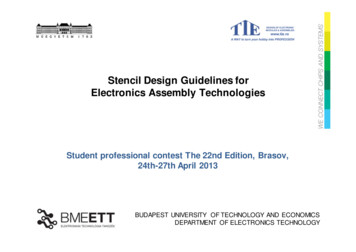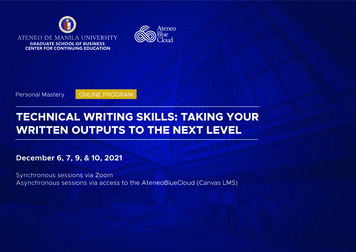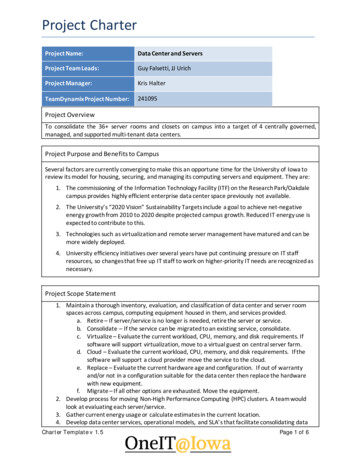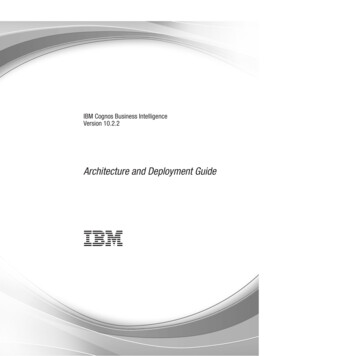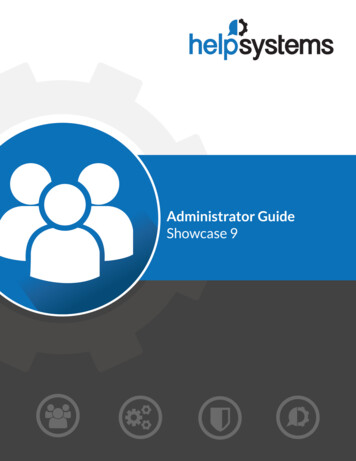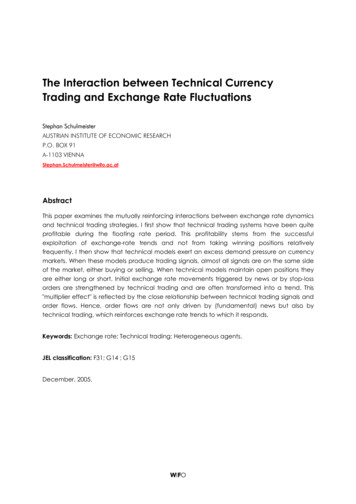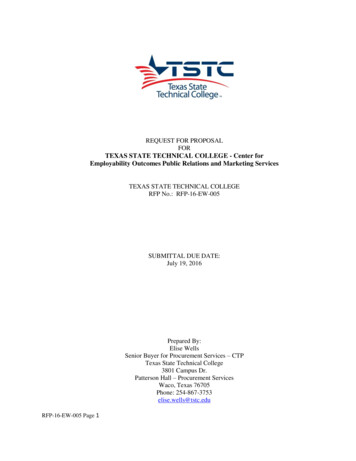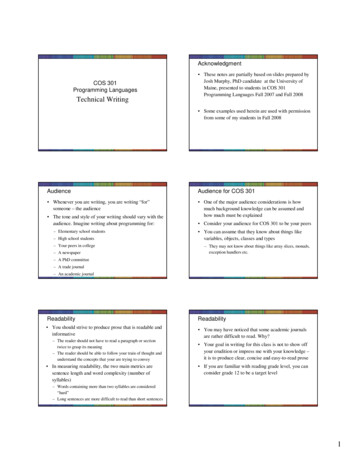
Transcription
TechnicalData Book PDF with Bookmarks to Sections and Links to Individual Products
INSTRUCTIONS AND FEATURESThank you for your interest in Eutectic Corporation. This PDF is an electronic data guide of our weldingelectrodes, rods, wires, powders, fluxes, equipment and wear plates. To ensure that you’re getting fulluse of this guide, you’ll need to download the most current version of Adobe Reader athttp://www.adobe.com/products/acrobat.Two features we’ve added to this PDF that will be useful in accessing and using our information are asfollows:1) Bookmarks. When you click on this icon(both here and on the left hand side of the PDF Page)you’ll get a list of our data book sections. By clicking on each link, you’ll come to that product area.2) Links. Links may be accessed in three ways. One way is to scroll to the rear of the book and find the“Quick Index by Product Name”. The second way is to use the Bookmarks and click on “Quick Index byProduct Name” (its the last bookmark in the list). A third way to access the Quick Index is to clickhere.Quick Index by Product Name. Once you’ve gone to the Quick Index, click on the product you’reinterested in seeing and you’ll be taken to that page. Notice that some products are on more than onepage. The first page has a link in red, the second page has a link in blue. You’ll need to click on eitherpage to visit that product. Once on the desired page, you’ll need to either scroll back to the rear of thebook or use the Bookmarks to return to the Quick Index.If you have questions about our products or this document please contact us at 800-558-5524.
TABLE OF CONTENTSSuperior Products for the Successful Practice of Maintenance & RepairWelding and Advanced Surface Coating TechnologiesSECTION 1 – ALUMINUM-BASE PRODUCTSBrazing Products:Welding Products:Product Information.21 FC-E, 190, 190 Al Paste, Auto Rad 21, 23, 2101,2109, 3021 (4021), 5356 1SECTION 2 – CAST IRON PRODUCTSBrazing Products:Welding Products:Product Information.11141, 146XFC DO*23, 27, Tig 224, 244, 2240, 2233N, 3055 (4055), 3099(4099), OA2600, DO*325 SECTION 3 – COBALT-BASE PRODUCTSBrazing Products:Welding Products:Product Information.Special request alloysDO*60, DO*80, 9060, 9080 24SECTION 4 – COPPER-BASE PRODUCTS (includes copper-base products fromother Sections)Brazing Products:Welding Products:Product Information.2816XFC, 16, 18XFC, 146XFC, 180, 3046XFC Tig 182, Tig 1851, 1851XHD, 1851, 2800XHD, AluBronze, Cop-Silicon, MCuAl SECTION 5 – BRAZING & SOLDERING PRODUCTSBrazing Products:Soldering Products:Product Information39180-no silver, 1804, 1020FC, 1020XFC, 1028FC, 1030FC,1601, 1630XFC, 1665XFC, 1800, 1801G, 1803, 1810,SilWeld Economizer Kit #2, Shim IV, Strip 1801G, 1618157, 157PA, TinWeld 2SECTION 5A – BRAZING & SOLDERING FLUXES & CHEMICAL AIDSBrazing Fluxes:Product Information56Xuper Braze Fluxes: 14D, 100, 100H, 100HD, 102, 190FP.Standard Fluxes: 190, 190Al, AutoRad FP, 141,i
Soldering Fluxes:Brazing Chemical AidsWonderFlux, 1020D, 1100, 1601, 1800, 1801, 1865, 16,16B, 16D, XuperFlo Paste, AutoRad FP, Castolin 8987051, 157, 682, 808 Anti-Capillary Compound, ExFlux 1005 Flux Remover,TinWeld Thinner, Eutect Instant Hardener #75, EutectoMask, EuCleen, Form-A-Jig, Solution 103 SECTION 6 – LOW ALLOY STEEL PRODUCTSBrazing Products:Welding Products:Product Information643046 XFC Refer to Sections 4 & 5 for more products.BeautyWeld II, SteelTectic N, 66N, 66XHD, 6666, 777,7018RS, 9708QS, DO*66, A88, OA 2020, Tig 66,DO*110, Super 110 SECTION 7 – HIGH ALLOY STEEL PRODUCTSBrazing Products:Welding Products:Product Information7816, 16 XFC Refer to Sections 4 & 5 for more products.670E, 680, 680CGS, 3026N, (4026N), 6800, 6868XHD,DO*68S, DO*110, Mig 6800, OA 688,OA 690, Tig 670, Tig 680, Tig 6800 SECTION 8 – NICKEL-BASE PRODUCTSBrazing Products:Welding Products:Product InformationRefer to Section 5 for suitable brazing products.2222N, 2222XHD 92SECTION 9 – PREMIUM & SPECIAL STAINLESS STEEL PRODUCTSBrazing Products:Welding Products:Product Information96Refer to Section 5 for suitable brazing products.A, AMoL, BMoL, D, 53L, 4057, Tig A, Tig AMoL,DO*29Sii
INDUSTRIAL STAINLESS STEEL PRODUCTSBrazing Products:Welding Products:AWS Specifications:A5.4, A5-9, A5.22Product Information106Refer to Section 5 for suitable brazing products.Electrodes: 308L-16, 308L-17, 308LVD-17, 309L-16,310-16, 316L-16, 316LVD-17.Mig Wires: 308L, 308LSi, 309L, 316LSi Tig Rods: 308L, 308LSi, 310, 316LSi Cored Wire: 308LTIFW SECTION 10 – HARDFACING PRODUCTSBrazing Products:Welding Products:Product Information108185XFC, 8800, R8811, 9000, 7888T, Electrodes: CaviTec SMA, 1XHD, 2B, 40, 112N, 646XHD, N700E, 4002, 4004N, 5003, 5005, N6006, 6710XHD, 6715 XHD, 6804XHD, 6899XHD, 7020, 7030,7040 EnDO Wires: CaviTec GMA, DO*05, DO*10, DO*11,DO*14, OTW-16, DO*17, DO*33, DO*327,DO*390N, DO*611 TeroMatec Wires: OA3010, OA3205, OA4601,OA4603, OA4625, OA4652, AN4811, OA4923,AN 4617, AN 4633 Fine Wires: FW-Chrom Iron, FW-High Chrom, FWMang Steel, FW-Mixed Carbide, FW-TungstenCarbide SECTION 11 – TOOL STEEL PRODUCTSProduct Information151Brazing Products:Refer to Section 5 for suitable brazing products.Welding Products:Electrodes: 6NHSS, 6NHW, 6SH,Tig Rods: Tig 5HSS, Tig 5HW, Tig 5AH, Tig OH, Tig5P20 SECTION 12 – METAL WORKING PRODUCTSMetal Preparation Products:Product Information159ChamferCut, ChamferTrode, CutTrode #1, ExoTrodeAC/DC iii
SECTION 13 - COATING PRODUCTSEUTALLOY THERMAL SPRAY POWDERSProduct Information160Eutalloy 10xxx Series Powders:10009, 10011, 10020, 10092, 10112,10146, 10180, 10185, 10224, 10680,10999N Eutalloy 11xxx Series Powders:11490, 11493, 11494, 11496, 11497,11498 Eutalloy 12xx Glass Mold Powders:1202, 1203, 1204, 1205, 1206, 1207-airEutalloy 9xxx & 8xxx Glass Moldassist powder, 1210 Powders:9001, 9002, 9003, 9005, 8718, 8726 Eutalloy CPW 5xxx Tungsten5127,5057N, 1249-special, 1873-special,Carbides Powders:Eutalloy X-TraLife 4xxx Series4510, 4520, 4530, 4540,4550 Powders:Air-Assist Systems 12xxx Powders:12494, 12496 SECTION 14 – COATING PRODUCTSPROXON 19XXX MICROFLOW POWDERSProduct Information170RotoTec 1A System Powders:19121, 19122, 19132, 19132S, 19171 SECTION 15 – COATING PRODUCTSPROXON 21XXX MICROFLOW POWDERSProduct InformationTeroDyn & CastoDyn System Powders: 21021, 21022, 21023, 21031, 21032S,21041, 21071 171SECTION 16 – COATING PRODUCTSMETACERAM 23XXX & 13XXX FUSIBLE POWDERSProduct Information173TeroDyn & CastoDyn System Powders: 23005, 23045, 23065, 23075, 13017,13494,13495, 13496 iv
SECTION 17 – COATING PRODUCTSMETACERAM 25XXX CERAMIC POWDERSProduct Information175TeroDyn & CastoDyn System Powders: 25010, 25020, 25030, 25040, 25050, 25060,25088 SECTION 18 – COATING PRODUCTSMETACERAM 29XXX 2-STEP POWDERSProduct Information176TeroDyn & CastoDyn System Powders: 29011, 29012, 29021, 29029, 29061, 29077,29079, 29096, 29123, 29210, 29230 SECTION 19 – COATING PRODUCTSMETACERAM CPW 1xxx 1-STEP POWDERSProduct InformationTeroDyn & CastoDyn System Powders: 1720, 1954, 1960, 1961, 5018-whitenylon , 5094-gray nylon 179SECTION 20 – COATING PRODUCTSGAP 375 16xxx EUTROLOY POWDERSTransferred-arc PAT Systems:Product Information18016001, 16006, 16012, 16112, 16113, 16220,16221, 16227, 16300LC, 16410, 16495,16496, 16496A v
SECTION 21 – COATING PRODUCTSTEROJET HVOF 55-xxx PPWDERSProduct Information183TeroJet System (HVOF Systems):55-116, 55-125, 55-396, 55-575, 55-583, 55588T, 55-588VF, TeroJet 2506-specialSECTION 22 – COATING PRODUCTSPLASMA NON-TRANSFERRED-ARC 18xxx POWDERSProduct InformationPlasma Non-transferred Arc System:18910, 19923, 18995Specialized Application Powders:185EverTuff ET 11 Thermoplastic, UltraBond5000 SECTION 23 – COATING PRODUCTSABRACOR COMPOSITES (EPOXY-BASED MATERIALS)Manual Application:Product Information187Express, General Repair, Ceramic Rebuild,Ceramic Rebuild OF, Ceramic Brush-On,Ceramic Paint-On, AbraCor Kevlar 5,AbraCor Kevlar Hi-Temp.SECTION 24 – EUTECDUR WEAR PLATESCASTOTUBE & EUTECDUR CDP PLATESProduct Information192CastoTube:Selected Diameters & OverlaysSelected Overlay EutecDur Thicknesses CDP 112, CDP 4603, CDP 4666, CDP 4923,CDP 6503 vi
SECTION 25 – EQUIPMENTSafety Equipment:Thermal Spray Equipment: Product Information194AirLux 3000, Assorted Oxy-fuel GasEutalloy Torches & Kits, SuperJet Torches& Kits, TeroDyn 2000 & 3000 Systems,CastoDyn 8000 System, TeroJet AC,EuTronic GAP System Technical Information & ReferencesProperties of Metals, Alloys and MaterialsSpark Test for MetalsHardness Conversion Chart – Hard Metals & AlloysHardness Conversion Chart – Cast Irons & Non-ferrous MetalsTemperature Conversions Metric Conversion ExamplesPowder Sieve Mesh ReferencesPreheat Temperatures by Steel ClassificationTool Steel Heat Treatment DataTemperature Conversion Data & Color Schemevii197
SECTION 1 – ALUMINUM-BASE PRODUCTSMetal NotesThe use of aluminum and its many alloys has grown steadily since it was first isolatedfrom bauxite (after Les Baux in France where it was first discovered in 1821). Afteroxygen and silicon, aluminum is the third most abundant element in the earth’s crust.Aluminum is a unique metal: It is lightweight and strong and an excellent conductor ofboth heat and electricity. In fact aluminum is second only to copper in terms of electricalconductivity on an equal volume basis. However, weight-for-weight it is twice asconductive as copper. One should note, too, that aluminum’s heat transfer properties areessentially similar to copper which is why it is necessary to preheat when brazing and/orwelding aluminum and its alloys.Weldable Aluminum GradesTypical Series1000 (EC)2000 with copper3000 with manganese4000 with silicon5000 with magnesium6000 with silicon &magnesium7000 with zincApplication UsageWeldabilityElectrical conductors is the most common usage.Grades 2014 & 2024 are used in aircraft fabrications.Grade 3003 is the typical. General purpose aluminum.Grades 4343 & 4043 are used for brazing & welding.Grade 5356 is typical. Used tanks, vessels, boats, etc.Grade 6061 is typical. Used for structural applicationsand for medium strength forgingsGrade 7039 is typical. aircraft structural framesGoodPoorGoodGoodGoodGoodPoorCast Aluminum Alloys: Common casting grades are typically high in silicon which makesthem fairly easy to weld-repair.Aluminum can be readily joined either by soldering and brazing, and by many of the arcwelding processes such Shielded Metal-arc, Gas Tungsten-arc, and Gas Metal-arcProcesses. However, it is known as a “white metal” which could be confused withmagnesium which is also white. A simple test to determine what metal it is the “AcidTest”. Use a few drops of EutecSol 682 or battery acid and see if any reaction happens.If it bubbles and turns black the metal is magnesium. If there is no reaction-such asbubbling, the metal is aluminum.ALUMINUM FILLER METAL SELECTION TABLESolderingEutecSol 51Special RodBrazingEutecRod 21FC-EEutecRod190Xuper Braze 190 AlXuper Braze AutoRadSMAWeldingEutecTrode 2101Xuper 2109EutecTrode 3021EutecTrode 40211GTAWeldingTigTectic 21TigTectic 23GMAWeldingMigTectic 4043MigTectic 5356
EUTECROD 21FC-E ALUMINUM BRAZING RODUNIQUELY FORMULATED FOR BOTH BUILD-UP AND THIN FLOWINGPROPERTIES ON CASTINGS AND THICK-WALLED EXTRUSIONSCNTENTSGeneral PropertiesEutecRod 21FC-E is a flux-coated brazing rod with excellent build-up properties. Can beused to repair cracks or re-build missing sections. Good color match with smooth,uniform fillets. Can be used on such common cast grades as 122, 355, and 356 & C612.Excellent for joining Grades 1xxx, 3xxx, 4xxx, and commonly used 5xxx & 6xxx grades.ApplicationsCasting repairs, foundry patterns, aluminum framing, particularly when gaps are present,pump housings, differential casings, missing sections, agricultural implements, etc.Technical Data Typical Tensile Shear Strength33,000 psi227 N/mm2 Electrical Conductivity IACS39% Solidus Temperature1090 F585ºC Liquidus Temperature1170 F630ºC Max. Brazing Temperature1190 F640ºC Heating MethodsOxy-fuel, resistance, induction Color Match PropertiesSimilar to cast aluminum (will darken if anodized) Note: EutecTor 190 flux can be used as a supplemental flux.Brazing ProcedurePreparation: Clean joint area and lightly abrade using a stainless steel wire brush or wirewool. Butt joints and/or broken sections should have a 60º-80º bevel with a root openingof 1/16” to 1/8”. Preheat in the range of 500º to 700ºF. Supplemental Eutectic 190 fluxcan be applied to the joint by making a paste with a small amount of water or alcohol.Technique: Adjust the oxy-fuel flame so that it is slightly reducing or carburizing. Keepthe torch moving from side-to-side. When the flux becomes molten apply the alloy usinga bead-forming technique. Do not melt the base metal. Cool slowly.Post-brazing: Remove flux, scrubbing in hot water and rinse. Note: It is mandatory toremove all traces of flux residues. If these are not removed they will cause corrosion.2
EUTECROD 190 ALUMINUM BRAZING RODA SPECIAL LOW-TEMPERATURE TORCH BRAZING ROD FOR HIGHSTRENGTH JOINING OF ALUMINUM TEE AND LAP JOINTS.OCNTENTSGeneral PropertiesEutecRod 190 provides exceptional thin-flowing properties when oxy-fuel brazing sheet,tubing and most wrought forms of aluminum. Excellent color match with smooth,uniform fillets. Properties are highly compatible with aluminum grades 3xxx & 4xxx.ApplicationsRepairing automotive, bus and light-gauge truck bodies. Irrigation piping, farmingimplements, office furniture, refrigeration, air-conditioning equipment, etc.Technical Data Typical Tensile Shear Strength34,000 psi234 N/mm2 Electrical Conductivity IACS42% Solidus Temperature1070 F575ºC Liquidus Temperature1080 F580ºC Max. Brazing Temperature1120 F605ºC Heating MethodsOxy-fuel, resistance, induction Color Match PropertiesSimilar to wrought aluminum (will darken if anodized) Note: EutecRod 190 requires the use of EutecTor 190 flux.Brazing ProcedurePreparation: Clean joint area and lightly abrade using a stainless steel wire brush or wirewool. For best results a slight gap of between .005” and .010” is recommended. Nopreheat is necessary with thin gauge material. For thicknesses up to 1/8” a nominal broadpreheat of 200ºF is suggested. Eutectic 190 flux can be applied to the joint by making apaste with a small amount of water or alcohol.Technique: Adjust the oxy-fuel flame so that it is slightly reducing or carburizing. Keepthe torch moving rapidly to prevent localized overheating with the inner flame cone 1” to2” from the joint. When the flux becomes molten apply the brazing alloy at equal pointsalong the joint seam. Cool slowly.Post-brazing: Remove flux, scrubbing in hot water and rinse. Note: It is mandatory toremove all traces of flux residues. If these are not removed they will cause corrosion.3
Xuper Braze AutoRadA PREMIUM BRAZING ROD FOR APPLICATIONS ON MOST GRADES OFALUMINUMGeneral PropertiesThis specially designed alloy offers superior cleaning action and is specially formulatedfor Aluminum applications. This product is specially formulated for radiator andcondenser repairs. This is a key product when sealing tube-to-header leaks and leaks intube-to-block assemblies, offering high tensile strength joints as well as corrosionproperties comparable to aluminum.ApplicationsTubes, Hoses, Radiators, Condenser, Oil Coolers, Boat Hulls, Rails, Extruded AluminumShapes, and Air Coolers.Technical Data Typical Tensile Strength Melting Temperature Color Match to Aluminum Type of Fuel Gas Electrical Conductivity IACSXuper Braze Auto Rad34,000 psi234 N/mm2Solidus 900 F (482º C) Liquidus 925 F (496º C)Very GoodPropane-Air42%Brazing ProcedurePreparation: Use a clean stainless steel wire brush to remove all surface contamination.Remove all chemical residues with an OSHA-approved solvent.Technique: Apply flux to area that is to be repaired. Slowly bring up to temperature.Keep the torch moving to prevent localized overheating, and note that the flux isformulated to take a direct flame assault. When the flux becomes liquid add filler metalto desired area using a scratching motion. Allow to slow cool in air and remove fluxresidue via water and a soft brush.Note: All Flux Residues Must Be Removed To Prevent Corrosion4
GeneralPropertiesXuper Braze190Aluminum PasteA SPECIAL LOW-TEMPERATURE TORCH BRAZING PASTE FOR HIGHSTRENGTH JOINING OF ALUMINUMGeneral PropertiesXuper Braze Paste is a premium aluminum-brazing alloy for either manual use or forvolume production automated processes. It is used to braze most aluminum gradesincluding the more difficult Series 6xxx and aluminum alloys. Especially effective whenused for dissimilar metal joining of aluminum-to-stainless steel. The paste is noncorrosive and is not necessary to remove flux residues after brazing.ApplicationsPipes, ducts, ventilation and air conditioning systems, heat exchangers and radiators.Fabrication of frames and chassis. Electrical appliances, heating systems, bus bars.Technical Data Typical Tensile Strength Melting Temperature Color Match to Aluminum Type of Fuel Gas Electrical Conductivity IACSXuper Braze 190 Al Paste34,000 psi234 N/mm2Solidus 1070 F (577º C), Liquidus 1080 F (582º C)Very GoodOxy-Fuel42%Brazing ProcedurePreparation: Use a clean stainless steel wire brush to remove all surface contamination.Remove all chemical residues with a suitably OSHA-approved solvent.Technique: Apply paste to area that is to be repaired, and slowly bring up totemperature. Keep the torch moving, to prevent localized overheating, and the paste isnot designed to take a direct flame assault. Allow to slow cool in air and remove fluxresidue via water and a soft brush.5
TigTectic 21 & 23 GTA RODSVERSATILE, AND QUALITY EXTRUDED GAS TUNGSTEN ARC RODS FORMAINTENANCE & PRODUCTION WELDING OF WROUGHT AND CASTALUMINUM ALLOYSGeneral PropertiesGas tungsten-arc welding of aluminum provides for a cosmetically clean and oxide-freeweld deposit. No post-welding clean up is necessary. Alloys can be used in all-positionsdepending on the skill of the welder. Eutectic 21 is recommended when welding 1xxx, 3xxx & 4xxx grade alloys. Eutectic 23 recommend when welding the high strength aluminum-magnesium grades(5xxx group). Also suitable for grade 6061.Applications Eutectic 21 is particularly suitable for maintenance welding office furniture, appliances,light-gauge aluminum auto bodies, refrigeration components, etc. Eutectic 23 is used for fabrications involving 5xxx series alloys where good strengthand improved anodized color match are required.Technical DataTigTectic 21TigTectic 232227N/mm Typical Tensile Strength33,000 psi35,000 psi 240 N/mm2 Typical Yield strength28,000 psi 192 N/mm2 29,000 psi 200 N/mm2 Typical Hardness (BHN)45%75% Electrical Conductivity IACS39%41% Color Match PropertiesGood *Good** Current & PolarityUse alternating current with imposed high frequency. Note: TigTectic 21 will darken after anodizing. Eutectic 23 will darken only marginally.Welding ProcedurePreparation: Thin sections can be welded after suitable cleaning and surface oxideremoval. Square-butt welding is acceptable for thin-gauge material. Thicker sectionsshould be beveled to give a minimum included angle of 60º. The selection of thepreferred zirconated tungsten diameter will depend on the material thickness andcorresponding amperage range. This applies similarly to gas cup size. Note: Make sure toround the tip of the electrode for better heat transfer and to minimize tungsten erosion.Heavy sections should be preheated within the range of 500º to 800ºF for non-heattreated alloys.Technique: Adjust argon shielding gas flow. Complex, or large parts, should besupported by tack-welds and jigs. Adjust stand-off distance so that the molten pool isalways protected by the shielding gas and allow the rod-end to solidify before removing itfrom the gas envelope. Slow cool after welding.6
EUTECTRODE 2101 - DCEPA PATENTED, FLUX EXTRUDED ELECTRODE FOR HEAVY ALUMINUMCASTINGS, LONG JOINTS, DEFECT FILLING, AND REBUILDINGMISSING SECTIONSGeneral PropertiesShielded metal-arc welding of aluminum is easy and quick with EutecTrode 2101. Welddeposits are dense and porous-free. Arc is smooth and stable which makes this electrodevery user-friendly. Weld deposits have a good color match with most casting grades. Slagremoval is easy once the part has cooled down.ApplicationsFor welding engine blocks, cast differential housings, various aluminum pump casings,heavy gauge aluminum truck bodies, foundry patterns, aluminum rails, etc.Technical Data Typical Tensile Strength Typical Yield strength Typical Hardness (BHN) Electrical Conductivity IACS Color Match Properties Current & PolarityEutecTrode 210134,000 psi234 N/mm228,000 psi192 N/mm24539%Good, but will darken after anodizing.Use direct current electrode positive ( )Welding ProcedurePreparation: Clean weld area to remove contaminants and surface oxides. Parts thickerthen 1/8” should be beveled to have an included angle of 60-75º. Preheat heavy sections,or sections thicker than a ¼” within a 400-500ºF range. Note: Preheating reduces theneed to use high amperage levels.Technique: Start arc either by lightly drawing the electrode across the work piece or usea copper starting block. To help control the arc response it is important to maintain a veryshort stand-off distance and to keep the electrode almost perpendicular. Back-whipcraters and allow to cool before deslagging.Post-welding: Slag removal is very important. It can become corrosive if not removed.Scrub in hot, soapy water and rinse.7
EUTECTRODE 3021 - DCEPA PATENTED, FLUX EXTRUDED ELECTRODE FOR HEAVY ALUMINUMCASTINGS, LONG JOINTS, DEFECT FILLING, AND REBUILDINGMISSING SECTIONSGeneral PropertiesShielded metal-arc welding of aluminum is easy and quick with EutecTrode 3021. Welddeposits are dense and porous-free. Arc is smooth and stable which makes this electrodevery user-friendly. Weld deposits have a good color match with most casting grades. Slagremoval is easy easy the part has cooled down.ApplicationsFor welding engine blocks, cast differential housings, various aluminum pump casings,heavy gauge aluminum truck bodies, foundry patterns, aluminum rails, etc.Technical DataEutecTrodes 3121 Typical Tensile Strength34,000 psi234 N/mm2 Typical Yield strength28,000 psi192 N/mm2 Typical Hardness (BHN)45 Electrical Conductivity IACS39% Color Match PropertiesGood, but will darken after anodizing. Current & PolarityUse direct current electrode positive ( )NOTE: Data page references apply equally to the distributor product EutecTrode 4021.Welding ProcedurePreparation: Clean weld area to remove contaminants and surface oxides. Parts thickerthen 1/8” should be beveled to have an included angle of 60-75º. Preheat heavy sections,or sections thicker than a ¼” within a 400-500ºF range. Note: Preheating reduces theneed to use high amperage levels.Technique: Start arc either by lightly drawing the electrode across the work piece or usea copper starting block. To help control the arc response it is important to maintain a veryshort stand-off distance and to keep the electrode almost perpendicular. Back-whipcraters and allow to cool before deslagging.Post-welding: Slag removal is very important. It can become corrosive if not removed.Scrub in hot, soapy water and rinse.8
XUPER 2109 - DCEPEXTRUDED ELECTRODE FORMULATED TO WELD ALUMINIUMALLOYS CONTAINING MAGNESIUM. SUPERIOR CRACKRESISTANCE ON CASTINGS & WROUGHT ALLOYSGeneral PropertiesA smooth running electrode with little or no spatter. Deposits are porous-free with auniform profile. Xuper 2109 is particularly useful when welding Grade 5xxx and 6xxxaluminum alloys either in the down-hand position or out-of-position. Can be used forboth joining and cladding.ApplicationsExcellent for repairing tanks & containers and structural frames. Particularly useful forcrack repairs to truck floor-bodies and aluminum casting grades containing magnesium.Technical DataXuper 2109 Typical Tensile Strength Typical Yield strength Typical Hardness (BHN) Electrical Conductivity IACS Color Match Properties Current & Polarity35,000 psi29,000 psi240 N/mm2200 N/mm27039%Good, but will marginally darken after anodizing.Use direct current electrode positive ( )Welding ProcedurePreparation: Clean weld area to remove contaminants and surface oxides. Parts thickerthen 1/8” should be beveled to have an included angle of 60-75º. Preheat heavy sections,or sections thicker than a ¼” within a 400-500ºF range. Note: Preheating reduces theneed to use high amperage levels.Technique: Start arc either by lightly drawing the electrode across the work piece or usea copper starting block. To help control the arc response it is important to maintain a veryshort stand-off distance and to keep the electrode almost perpendicular. Back-whipcraters and allow to cool before deslagging.Post-welding: Slag removal is very important. It can become corrosive if not removed.Scrub in hot, soapy water and rinse.9
MIGTECTIC 5356 - DCEPA CONTINUOUS SOLID ALUMINUM WIRE WITH CONTROLLEDSTIFFNESS AND SURFACE SMOTHNESS FOR EASE OF USEAND HIGHEST QUALITY WELDSGeneral PropertiesMigTectic 5356 is an aluminum-magnesium wire die-drawn & polished to maintain wiresmoothness, stiffness and hardness. These properties result in trouble-free wire feedingwith most push and push-pull systems. The alloy is suitable for welding the 5xxx and6xxx grades and associated castings.ApplicationsFor porous-free welding of aluminum forgings, castings and wrought alloys containingmore than 3% magnesium. Typical grades welded with MigTectic 5356 are 5356: 3003,5052, 5083, 6061, 6063, and 7039.NOTE: Properties are given in the Technical Data TableTechnical Data Table re MigTectic 5356 Usage PropertiesAluminum Alloy Grades Grade 6061 Grade 6063 Grade 3003 Grade 5052 Grade 5083 Grade 7039 Current & Polarity Shielding GasMigTectic 5356 PropertiesUse for strength and ductilityUse for strength, ductility & anodized color matchingUse for improved strengthUse for strength, ductility & anodized color matchingUse for strength, ductility & anodized color matchingUse for improved ductilityUse direct current electrode positive ( )Welding grade argonWelding ProcedurePreparation: Parts must be clean, oil-free, and free from moisture. Surface oxidesshould be removed mechanically with stainless steel abradants. Jigs and supports shouldbe used for thin gauge material. Check that the drive-rolls are smooth “u” shaped and thatthe gun cable liner is either Nylon or Teflon . A preheat of 300ºF is helpful for partsthicker than 1/2”.Technique: The recommended electrode extension or “stick-out” is 3/8” beyond theshielding gas nozzle. Shielding gas flow rates should not be less than 30 scfh and notmore than 60 scfh. The gun assembly should be tilted no more than 10 in the forehanddirection.Post-welding: Slow cooling is recommended to reduce cool-down stressing.10
SECTION 2 – CAST IRON PRODUCTSMetal NotesThe brazing and arc welding of most types of cast iron can be carried out successfully.Although a “crack sensitive” metal when welded without following establishedprocedures, using the proper preparation, preheat, welding product, technique, andapplying post-welding controls, will in most cases, guaranty a successful repair. Preparation: What steps to undertake depend on the type of failure. For example: 1) Isthe part broken into two or more parts? 2) Is the crack open-ended? That is, does thecrack start in the body of the cast iron and terminate at an edge or lip? 3) Is the crackenclosed or contained within the body of the cast iron? This is a crack with no open ends.In the first example the part(s) should be chamfered by arc-gouging with ExoTrode AC/DC or ChamferTrode , or by grinding, or machining. In examples 2 & 3 thestandard practice is to drill a 1/8-in.diameter hole at the crack-end to prevent furthercrack propagation. Note: When using arc-gouging it is advisable to grind the chamferedsurface layer to remove any potential hard spots. Preheat & Interpass Temperature Controls: Careful preheating of cast irons has anumber of application advantages: Firstly, it expands the base metal that, after weldingand subsequent cooling, puts the weld metal in to beneficial compression. Secondly, itreduces the hardness gradient in the heat-affected zone (HAZ). And, thirdly, it reducesexcessive thermal contraction mismatching with its potential cracking tendencies. Ageneral preheat range for most weldable grades of cast iron is 200º to 500ºF. A typicalinterpass temperature is 100ºF. Low Preheat Welding: The general procedure is similar to that practiced at higherpreheats. A low preheat 100-200ºF and a more restricted interpass temperature of 50ºF,reduces thermal gradients and contraction stresses. Welding Product Selection: Please refer to the Product Selection Table for your guidein selecting the best product for specific cast irons and general properties.Product Selection TableProduct141146XFCDO*2327Tig 22424422402233N3055 40553099 4099OA 2600DO*325Application KeyFor gas fusion welding gray cast irons for soft machinable welds.For braze welding of gray, malleable, and lower-strength ductile irons.A metal-cored wire for welding gray, ductile, and compacted irons.Non-machinable, buttering electrode for porous & dirty cast irons.A GTA rod for thin-walled SG, ductile, and gray cast irons.For welding oil-soaked cast irons.Low heat input welding of spheroidal graphite (SG) irons.Optimized properties when welding ductile irons with low preheat.Formulated for crack-free welding of gray cast irons.Improved machinable weld deposits on gray cast irons.Repairing defects in mill rolls & automotive diesFor crack-free hardfacing & anti-wear properties on most cast irons11
Welding Technique: A stringer-bead technique is recommended when welding allgrades of cast iron. Short beads about 2” long will reduc
Data Book PDF with Bookmarks to Sections and Links to Individual Products. Thank you for your interest in Eutectic Corporation.This PDF is an electronic data guide of our welding electrodes, rods
